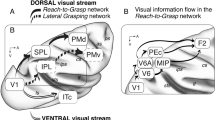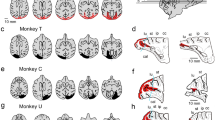Abstract
Positron emission tomography (PET) was used to identify the brain areas involved in visually guided reaching by measuring regional cerebral blood flow (rCBF) in six normal volunteers while they were fixating centrally and reaching with the left or right arm to targets presented in either the right or the left visual field. The PET images were registered with magnetic resonance images from each subject so that increases in rCBF could be localized with anatomical precision in individual subjects. Increased neural activity was examined in relation to the hand used to reach, irrespective of field of reach (hand effect), and the effects of target field of reach, irrespective of hand used (field effect). A separate analysis on intersubject, averaged PET data was also performed. A comparison of the results of the two analyses showed close correspondence in the areas of activation that were identified. We did not find a strict segregation of regions associated exclusively with either hand or field. Overall, significant rCBF increases in the hand and field conditions occurred bilaterally in the supplementary motor area, premotor cortex, cuneus, lingual gyrus, superior temporal cortex, insular cortex, thalamus, and putamen. Primary motor cortex, postcentral gyrus, and the superior parietal lobule (intraparietal sulcus) showed predominantly a contralateral hand effect, whereas the inferior parietal lobule showed this effect for the left hand only. Greater contralateral responses for the right hand were observed in the secondary motor areas. Only the anterior and posterior cingulate cortices exhibited strong ipsilateral hand effects. Field of reach was more commonly associated with bilateral patterns of activation in the areas with contralateral or ipsilateral hand effects. These results suggest that the visual and motor components of reaching may have a different functional organization and that many brain regions represent both limb of reach and field of reach. However, since posterior parietal cortex is connected with all of these regions, we suggest that it plays a crucial role in the integration of limb and field coordinates.
Similar content being viewed by others
Author information
Authors and Affiliations
Additional information
Received: 23 August 1995 / Accepted: 8 August 1996
Rights and permissions
About this article
Cite this article
Kertzman, C., Schwarz, U., Zeffiro, T. et al. The role of posterior parietal cortex in visually guided reaching movements in humans. Exp Brain Res 114, 170–183 (1997). https://doi.org/10.1007/PL00005617
Issue Date:
DOI: https://doi.org/10.1007/PL00005617




